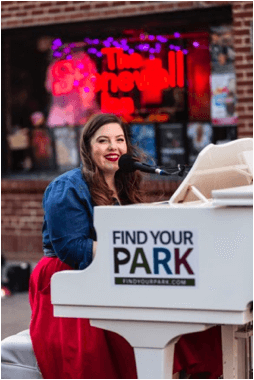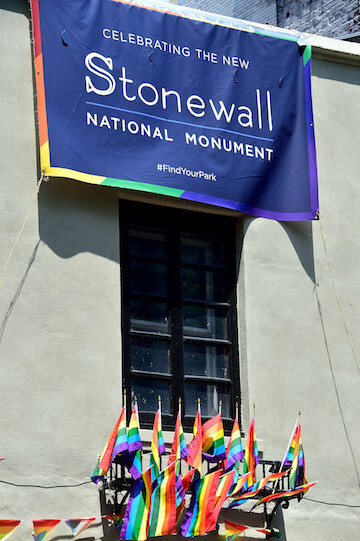City Council Speaker Corey Johnson, at a May 20 West Side Summit at the High Line, said he was not consulted on the parade route change. | DUNCAN OSBORNE
On April 25, members of the Reclaim Pride Coalition presented Heritage of Pride (HOP) with a list of demands, including an “honest and transparent explanation for the dramatic route change” that has the city’s annual Pride Parade beginning in Chelsea, traveling south on Seventh Avenue to Christopher Street, east to Fifth Avenue, and then north to end at 29th Street.
At HOP meetings on May 14 and May 15, Julian Sanjivan, who heads the HOP March Committee, was ready with a PowerPoint presentation. One bullet point suggested that West Village residents had complained and there were “too many complaints to not take further action,” it read. Those residents might not agree.
On Pride Sunday in 2017, there were 41 complaints made to the city’s 311 service concerning “loud music/ party” or “loud talking” within Community Board 2, which includes the West Village and is home to about 94,000 New Yorkers. On the Sunday before Pride last year, there were 12 noise complaints, and five noise complaints on the Sunday after Pride.
Residents are not complaining to Community Board 2.
“The parade was not changed due to complaints brought to the community board,” said Bob Gormley, the board’s district manager.
Speaker Corey Johnson, local community board say they weren’t consulted
Calls to 911 did go up on Pride Sunday last year. Residents living in the NYPD’s 6th Precinct, which includes the West Village, made 221 calls to 911 on the Sunday before Pride last year, 435 calls on Pride Sunday, and 163 calls on the Sunday following Pride.
Whatever those taxpayers were calling about, it was not serious crime. There were no murders in the 6th Precinct last year and just nine rapes, 139 robberies, and 131 felony assaults. It is among the safest precincts in the city.
HOP has responded by changing the route and limiting all contingents to fewer than 200 people. The group is expecting 41,000 marchers this year as opposed to 55,000 last year and fewer floats and vehicles. For the first time, the post-parade pier dance, now called Pride Island, and fireworks have moved from the West Village to Pier 97 on the Hudson River at the end of 57th Street. PrideFest, which, like the parade, takes place on the last Sunday in June, has moved to University Place between 13th Street and Waverly Place.
The theory is that the changes will make the Pride Parade shorter — it lasted just over nine and a half hours last year — and the crowd will use the greater access to public transportation in Midtown to travel to neighborhoods other than the West Village to celebrate.
“We don’t want everyone congesting in the West Village,” Sanjivan said at the May 14 meeting.
Julian Sanjivan, the march director at Heritage of Pride. | DONNA ACETO
Discussions among HOP, the Mayor’s office, the NYPD, the city Sanitation Department, and other city agencies that are involved in the parade — which commemorates the 1969 riots at the Stonewall Inn that mark the start of the modern LGBTQ rights movement — began in August 2017 and ended this past February when the NYPD selected the route from among those proposed by HOP.
Asked if reducing the cost of organizing, policing, and cleaning up after the parade was part of the city’s discussion with HOP, Mayor Bill de Blasio said he had not been briefed on the topic.
“If we have a route that can be shorter in terms of the impact it has on the surrounding communities, we should be looking at that, but I have not heard any of the details relating to this parade,” de Blasio said during a May 23 press conference at a Bronx school. “I would want to get briefed on it before I spoke to it… I think the impetus originally was as much about neighborhood impact, congestion, other factors as it was anything involving cost, but that began before this administration.”
While most of HOP’s meetings are open to the public, the organization gave little notice of the change, if any at all, to the broader community until after the new route was chosen and HOP began announcing it on social media. Corey Johnson, who represents the West Village in the City Council and won the Council speaker’s job this year, was among those who was surprised by the new route.
“No one asked me my opinion on this or included me in the process between the NYPD and the organizers at the Heritage of Pride,” Johnson told Gay City News. “I literally found out about this through seeing someone share it on Facebook, and I asked my staff to look into it.”
Between May 14 and May 15, Sanjivan added a bullet point to his PowerPoint presentation that read “Request from Corey’s office on route change.” That was the sole reference to Johnson or his staff. When Gay City News asked at the May 15 meeting if this meant that Johnson, who is openly gay, had not been consulted, one HOP member said that he was not the City Council speaker when the discussions started. Bruce Pachter, HOP’s community relations director, said Johnson’s Community Board 2 liaison had attended some meetings though he did not say if those were Community Board 2 meetings, which did not take up the route change, or meetings at which the route was discussed.
“We didn’t have anything to do with the change in the route of the parade,” Gormley said. “It was not brought to the community board.”
Johnson has reservations about the new route.
“I personally like the route we’ve marched on for years,” he said. “I have some pretty serious concerns about the new route. I’m not sure it’s long enough, I’m not sure that the staging is in the right area.”
The activists in the Reclaim Pride Coalition had multiple concerns. They wanted a resistance contingent in the parade. HOP has agreed to that though it will be limited to 10 groups.
HOP rejected the Coalition’s demand that members of the Gay Officers Action League (GOAL) be required to march without uniforms or weapons. HOP effectively postponed any demands about limiting policing of the parade until a June 5 town hall with the NYPD that will be held at the Lesbian, Gay, Bisexual & Transgender Community Center.
A major theme of the Coalition demands, consistent with longstanding complaints about the Pride Parade, is that it has become disconnected from its history, from the place where that history began, and from the radical politics that emerged before and immediately after the 1969 riots.
“This area is our home,” said Jay W. Walker, a member of the Coalition, referring to the West Village. Then speaking about the neighborhood’s current residents, he added, “I don’t really care about them.”
For some Coalition members, limiting the size of community group contingents, instead of limiting just corporate groups, was especially troubling.
“This really feels like a shrinking, a pulling back,” said Mark Milano at the May 15 meeting.






































